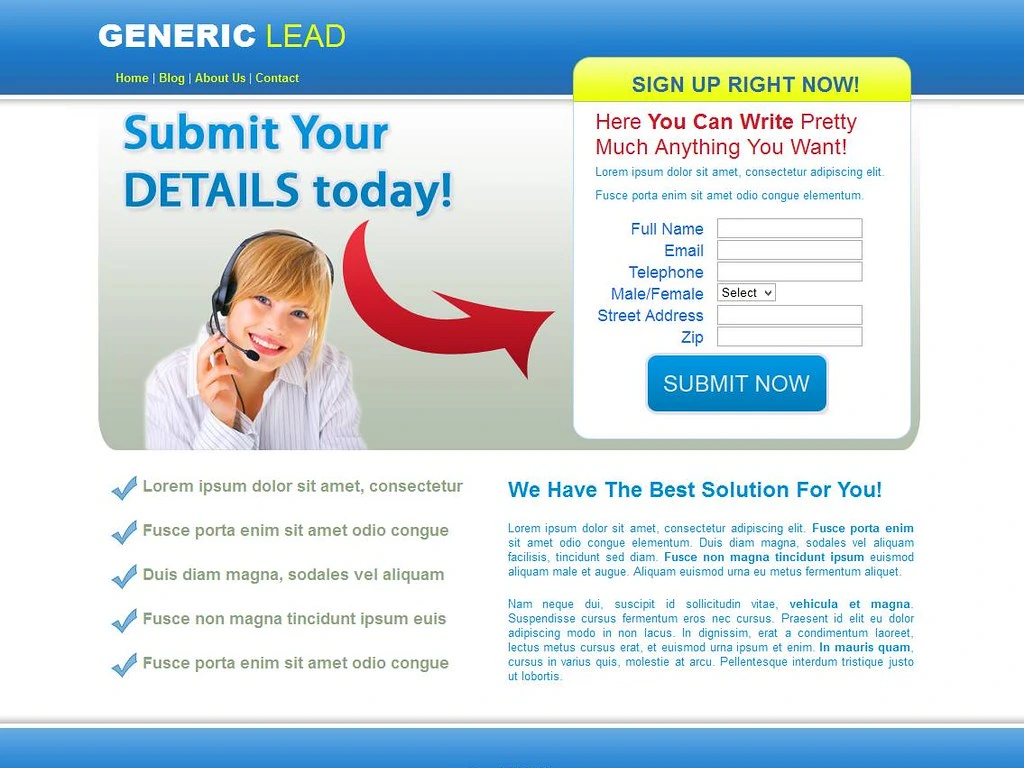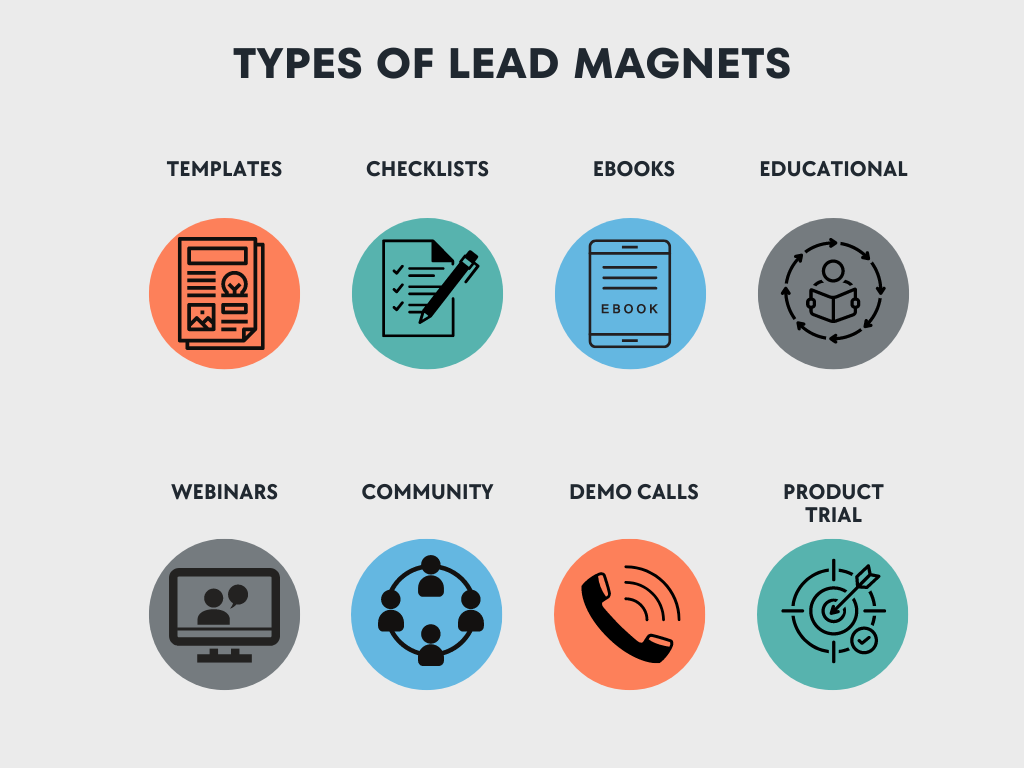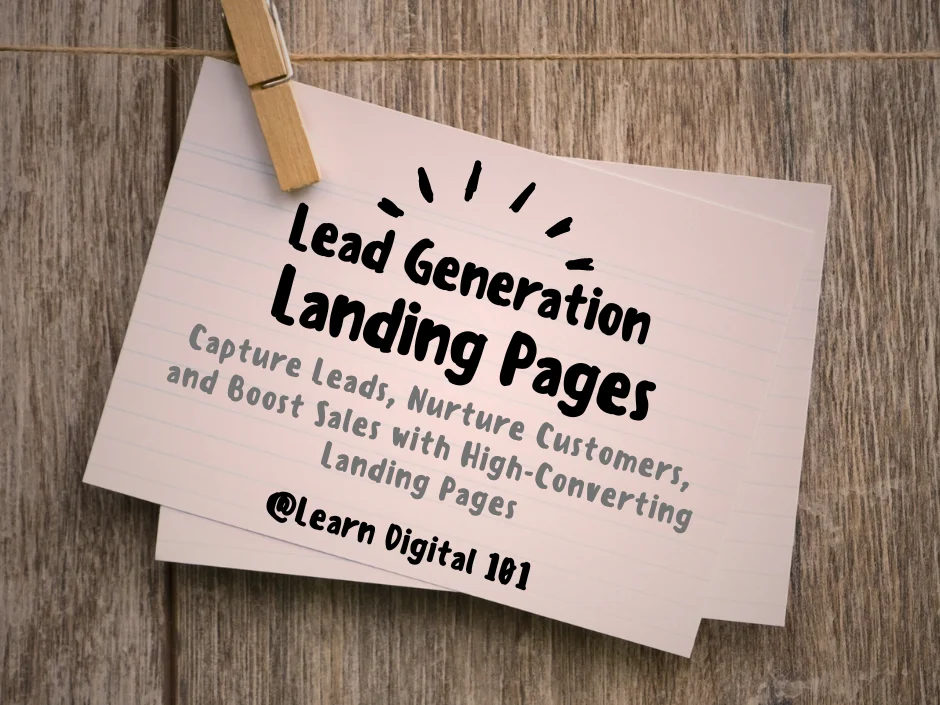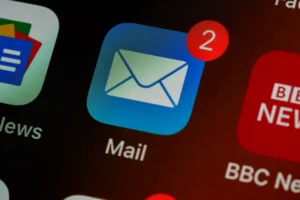Want to convert website visitors into leads but not sure where to start? Lead generation landing pages are powerful tools that can help you capture leads, grow your email list, and ultimately boost sales. This guide dives deep into everything you need to know to create high-performing landing pages that get results.
Lead generation landing pages are standalone webpages designed to capture visitor information in exchange for a valuable offer, such as an ebook, webinar, or free trial. They play a crucial role in converting website visitors into leads and nurturing them into sales. By crafting compelling landing pages with clear CTAs and valuable lead magnets, you can significantly increase their conversion rates and achieve marketing goals.
Ready to unlock the lead generation potential of landing pages? This guide explores essential elements for crafting high-converting pages, along with advanced strategies like A/B testing and progressive profiling. Learn valuable copywriting tips, discover tools to streamline the process, and uncover best practices to maximize your ROI. Dive deeper and unleash the power of lead generation landing pages for your business!
Understanding Lead Generation Landing Pages

In today’s digital marketing landscape, capturing leads is crucial for any business seeking to grow its customer base. Lead generation landing pages play a vital role in this process by serving as dedicated web pages designed to convert website visitors into potential customers.
What is a Lead Generation Landing Page?
A lead generation landing page is a standalone web page distinct from your main website. Visitors typically arrive at these pages after clicking on a link from an advertisement, email campaign, or other marketing source. Unlike your main website, which serves various purposes, landing pages have a singular focus: to convert visitors into leads.
This conversion process typically involves capturing visitor information, such as their name and email address, in exchange for a valuable offer. This offer, often referred to as a “lead magnet,” can take various forms, including ebooks, white papers, case studies, webinars, free trials, or demos.
Conversion Funnel Concept
Landing pages function within the broader concept of the marketing funnel. The marketing funnel visualizes the customer journey, from initial brand awareness to eventual conversion. At the top of the funnel lies a large pool of potential customers who may be interested in your product or service but haven’t yet interacted with your brand. Landing pages come into play further down the funnel, targeting individuals who have already shown some level of interest by clicking on a link or advertisement.
The purpose of a landing page is to move these interested visitors further down the funnel, ultimately converting them into leads. Once captured, these leads can be nurtured through email marketing campaigns, providing valuable content and building trust. This nurturing process ultimately aims to convert leads into paying customers.
Why Use Lead Generation Landing Pages?
There are several compelling reasons why you should incorporate lead generation landing pages into their digital marketing strategy:
- Targeted Audience Reach: Landing pages allow you to reach a specific audience segment interested in your offer. By tailoring the content and message to a particular demographic or need, you can significantly increase conversion rates compared to generic marketing efforts.
- Data Collection for Email List Building and Future Marketing Campaigns: Capturing visitor information through landing pages allows you to build a targeted email list. This list serves as a valuable asset for future marketing campaigns, enabling you to nurture leads with personalized content and special offers.
- Measurable Results for Landing Page Effectiveness and Optimization: Landing pages provide a controlled environment where you can track and measure visitor behavior. Analytics tools can reveal valuable insights, such as conversion rates, bounce rates, and time spent on the page. This data allows you to optimize your landing page for better performance and continuously improve your conversion strategy.
- Clear Call to Action (CTA) to Guide Visitor Actions: Landing pages differ from your main website by having a single, clear objective: to convert visitors into leads. This focus allows you to incorporate a prominent call to action (CTA) that guides visitors towards taking the desired action, such as downloading an ebook or subscribing to a newsletter.
By leveraging these advantages, lead generation landing pages can become a powerful tool for you to generate leads, build email lists, and ultimately drive sales growth.
Crafting High-Converting Lead Generation Landing Pages

Now that we understand the purpose and benefits of lead generation landing pages, let’s delve into crafting pages that effectively convert visitors into leads. Here are some key elements to consider:
Offer Valuable Content
The offer you present to visitors is undoubtedly the cornerstone of any successful lead generation landing page. However, you must go beyond simply offering a valuable freebie. They must also ensure that the offer is highly relevant to their target audience and effectively addresses their specific pain points or needs.
By tailoring their offers to their target audience, you can significantly increase their conversion rates, this offer, known as a lead magnet.
Examples of Lead Magnets:
- Ebooks: Offer downloadable ebooks packed with valuable information and insights relevant to your industry.
- White Papers: Provide in-depth white papers that explore complex topics and showcase your expertise.
- Case Studies: Demonstrate your success with real-world client case studies, highlighting the value you deliver.
- Webinars: Host informative webinars that address specific challenges your audience faces.
- Free Trials or Demos: Allow visitors to experience your product or service firsthand with a free trial or demo.
The type of lead magnet you choose will depend on your target audience and overall marketing goals. However, the key is to offer something truly valuable that incentivizes visitors to exchange their contact information for access.
Addressing Visitor Pain Points or Providing Valuable Insights:
Your landing page copy should clearly communicate the benefits of your lead magnet and how it addresses the specific needs of your target audience. Focus on highlighting the value proposition, demonstrating how the lead magnet can help visitors solve a problem, improve their skills, or achieve their goals.
Here are some questions to consider when crafting your lead magnet and the corresponding landing page copy:
- What are the biggest challenges or pain points faced by your target audience?
- How can your lead magnet help them overcome these challenges?
- What valuable insights or information does your lead magnet provide?
By aligning your lead magnet with your target audience’s needs and emphasizing the value it delivers, you can significantly increase the conversion rate of your landing page.
Write Persuasive Copy
The copy on your landing page plays a crucial role in convincing visitors to take action. However, simply writing persuasive copy is not enough. You must also ensure that their copy is clear, concise, and benefit-oriented.
You should also use strong calls to action that encourage visitors to take the desired action. By crafting compelling and persuasive copy, you can significantly increase their landing page conversion rates.
Here are some essential writing techniques to craft persuasive copy that drives conversions:
Clear, Concise, and Benefit-Oriented Language:
Avoid jargon and technical terms. Use clear, concise language that is easy for your target audience to understand. Focus on highlighting the benefits of your lead magnet and how it will help visitors achieve their goals.
For example, instead of stating, “Download our comprehensive SEO guide,” you could rephrase it as, “Unlock the secrets of higher search engine ranking with our free SEO guide. Increase website traffic and generate more leads!”
Compelling Headline that Grabs Attention and Accurately Reflects the Offer:
Your headline is the first thing visitors will see, so it needs to be compelling and capture their attention within seconds. Craft a clear and concise headline that accurately reflects the value proposition of your lead magnet.
Here are some tips for writing effective headlines:
- Use strong verbs and action language.
- Highlight the benefits of your lead magnet.
- Create a sense of urgency or curiosity.
- Keep it concise and easy to read.
Focus on Visitor Benefits Gained by Opting In:
Throughout your landing page copy, emphasize the benefits that visitors will gain by downloading your lead magnet. Don’t just focus on features, explain how those features translate into tangible results for your audience.
For instance, instead of simply saying, “Our white paper discusses the latest marketing trends,” you could rewrite it as, “Discover the top marketing trends that can help you outrun the competition and achieve explosive business growth. Download our free white paper now!”
By using clear, concise, and benefit-oriented language, you can create compelling copy that resonates with your target audience and motivates them to take action.
Design Considerations for Lead Generation Landing Pages

Visual appeal and user experience are undoubtedly important factors in the effectiveness of your landing page. However, you should not overlook the importance of mobile optimization.
In today’s mobile-first world, ensuring your landing page is responsive and optimized for viewing on all devices is essential for providing a seamless user experience and maximizing conversions.
Here are some key design considerations to keep in mind:
Design Matters:
- Professional and Visually Appealing Layout:
Strive for a clean and professional layout that aligns with your brand identity. Use high-quality visuals, such as images and graphics, that complement your message and enhance the overall user experience. - High-Quality Images and Graphics:
Professional and relevant images can significantly enhance your landing page. Choose visuals that resonate with your target audience and support your message. - Clean and Easy Navigation:
The navigation on your landing page should be clear and intuitive. Visitors should be able to easily find the information they need and understand how to take the desired action, typically filling out a form to download the lead magnet.
Mobile-Friendly Design:
In today’s mobile-first world, ensuring your landing page is responsive and optimized for viewing across devices (desktops, tablets, and smartphones) is essential. Test your landing page for mobile friendliness. A responsive design automatically adjusts the layout to fit the screen size of the device being used, providing an optimal viewing experience for all visitors.’
Here are some additional tips for mobile-friendly landing page design:
- Use large, easy-to-read fonts.
- Place the call to action (CTA) in a prominent location.
- Minimize the use of complex forms.
- Test your landing page thoroughly on different mobile devices.
By prioritizing both visual appeal and user experience, you can create landing pages that are not only aesthetically pleasing but also effective in converting visitors into leads.
Additional Landing Page Optimization Techniques
While the core elements discussed so far are crucial, additional optimization techniques can further enhance your landing page’s conversion rate. Here are some key strategies to consider:
- One Goal Per Page: Maintain a single, clear objective for your landing page. Avoid distractions by focusing solely on converting visitors into leads for your specific offer. Don’t attempt to promote multiple products or services on the same landing page.
- Only Ask for Essential Information: Limit the form fields on your landing page to the bare minimum required to capture a lead, typically name and email address. Longer forms with numerous fields can deter visitors from completing the form and decrease conversion rates.
- Message Match: Ensure consistency between your landing page copy and visuals, and the messaging used in your marketing campaign. This consistency builds trust and reinforces the value proposition across all touchpoints.
- Use Social Proof: Social proof elements like testimonials, logos of trusted brands, or customer reviews can significantly enhance your landing page’s credibility and encourage visitors to opt-in. Highlighting positive experiences from satisfied customers demonstrates the value of your offer and instills trust in potential leads.
By implementing these additional optimization techniques, you can streamline the user experience and remove any barriers that might prevent visitors from converting into leads.
Creating and Optimizing Your Landing Page
Now that we’ve explored the essential elements and optimization techniques, let’s delve into the practical steps of creating and optimizing your landing page:
1. Set Goals:
The first step is to define clear goals for your landing page. This could be a specific number of email signups, downloads of your lead magnet, or any other measurable action you want visitors to take. Defining clear goals allows you to track the performance of your landing page and measure its effectiveness in achieving your marketing objectives.
2. Write Compelling Copy:
As discussed earlier, the copy on your landing page plays a crucial role in conversions. Craft clear headlines, benefit-oriented content, and strong calls to action (CTAs) that entice visitors to take action. Use a conversational tone that resonates with your target audience and emphasizes the value proposition of your offer.
3. Include High-Quality Images:
High-quality visuals, such as images and videos, can significantly enhance your landing page’s impact. Choose visuals that are relevant to your offer and complement the overall design. Remember, visuals can help to break up text, capture attention, and enhance user experience.
4. Design and Build the Page:
Several options exist for creating your landing page. If you’re not a web developer, consider using dedicated landing page creation platforms like Unbounce, Leadpages, or Instapage. These platforms offer user-friendly drag-and-drop interfaces and pre-designed templates to simplify the process.
5. Integrate with Marketing Tools:
Ensure seamless integration between your landing page and your marketing automation platform. This allows you to automatically capture leads and nurture them with targeted email campaigns after they convert. Popular marketing automation tools include HubSpot, Mailchimp, and ActiveCampaign.
6. Publish and Optimize:
Once you’ve created your landing page, it’s time to launch it and monitor its performance. Utilize analytics tools like Google Analytics or Hotjar to track key metrics such as conversion rates, bounce rates, and time spent on the page.
7. A/B Testing:
A/B testing allows you to compare different versions of your landing page elements, such as headlines, copy, CTAs, or visuals. Understand A/B testing in-depth. This data-driven approach helps you identify what resonates best with your audience and continuously improve your landing page’s effectiveness. Popular A/B testing tools include Optimizely and Google Optimize.
By following these steps and employing a data-driven approach to optimization, you can create high-performing landing pages that effectively capture leads and drive conversions for your business.
Advanced Lead Generation Strategies
Having mastered the fundamentals, let’s explore some advanced lead generation strategies to further enhance your lead capture capabilities:
Advanced Targeting Strategies:
- Geo-targeting: Deliver location-specific offers relevant to the visitor’s geographic area. This can be particularly effective for businesses with local reach or those offering location-based services. Imagine a landing page promoting a free restaurant guide automatically adjusting to showcase the best restaurants in the visitor’s city.
- Behavioral targeting: Tailor content and offers based on visitor website behavior (pages visited, previous interactions). By leveraging website analytics data, you can display targeted landing pages to visitors who have expressed interest in specific products or services.
For example, if a visitor has viewed your pricing page for a marketing automation tool, a landing page promoting a free trial of that same tool could be displayed. - Retargeting: Reconnect with website visitors who haven’t converted yet through targeted ads or landing pages. Retargeting allows you to stay top-of-mind with potential leads and incentivize them to return and complete the desired action. This strategy could involve displaying ads showcasing your lead magnet to visitors who previously abandoned your landing page.
- Interactive Elements to Boost Engagement: Assessments or quizzes: Engage visitors and collect valuable data through interactive quizzes with gated results (available upon providing contact information). These quizzes can assess a visitor’s skill level or diagnose their specific challenges, making your lead magnet even more relevant and valuable.
- Calculators or ROI tools: Provide valuable tools that solve pain points and incentivize information sharing for results (e.g., SEO cost calculator, website traffic estimator). These interactive tools allow visitors to see the potential benefits of your product or service firsthand, making them more likely to convert.
By incorporating these advanced targeting and interactive elements, you can personalize the user experience, capture valuable lead data, and ultimately increase conversion rates.
Landing Page Copywriting Tips for Conversions:
- Focus on benefits, not features: Highlight how the lead magnet solves visitor problems and improves their lives. Don’t just list features, explain how those features translate into tangible results.
- Use strong verbs and action language: Motivate visitors to take action with compelling verbs in CTAs and throughout the copy. Hone your copywriting skills. Words like “download,” “subscribe,” “get started,” and “claim your free copy” create a sense of urgency and encourage visitor action.
- Speak directly to your audience: Use language and tone that resonates with your target demographic. Understanding their challenges and speaking directly to their needs helps build trust and establish credibility.
- Write clear and concise copy: Avoid jargon and technical terms. Use short sentences and paragraphs for easy reading and comprehension. Ensure your message is clear and easy to understand for your target audience.
By following these copywriting tips, you can craft compelling landing page copy that resonates with your audience and motivates them to take action.
Tools and Resources to Streamline Landing Page Creation:
Here are some helpful tools and resources to simplify your landing page creation and optimization process:
- Landing page creation platforms: Unbounce, Leadpages, Instapage (user-friendly interfaces and pre-designed templates)
- Marketing automation tools: HubSpot, Mailchimp, ActiveCampaign (manage email marketing campaigns and nurture leads)
- A/B testing tools: Optimizely, Google Optimize (compare different landing page elements for data-driven optimization)
- Analytics tools: Google Analytics, Hotjar (track key metrics and user behavior to measure performance)
By leveraging these tools and resources, you can streamline the landing page creation process, automate tasks, and gain valuable insights to continuously improve your conversion rates.
Advanced Lead Capture Techniques
While traditional landing pages with lead capture forms remain highly effective, exploring advanced lead capture techniques can further expand your lead generation capabilities. Here are some innovative strategies to consider:
Lead Capture Popups:
Strategically timed popups appearing on your website can capture leads without disrupting user experience. These popups can be triggered by exit intent (visitor about to leave the page), scroll depth (visitor has scrolled a certain distance down the page), or time spent on the page (visitor has been on the page for a specific duration).
However, it’s crucial to ensure the popup is relevant, provides value, and doesn’t obstruct the user journey. Here are some best practices for effective lead capture popups:
- Offer a valuable incentive: Present a compelling offer relevant to the content the visitor is viewing. This could be a discount code, a free downloadable resource, or early access to exclusive content.
- Target the right audience: Use website analytics or visitor behavior data to trigger popups for relevant visitors who have shown some level of interest.
- Time the popup strategically: Avoid overwhelming visitors with immediate popups. Consider triggering popups after a visitor has been engaged with your content for a reasonable amount of time or upon exit intent.
- Make it easy to close: Include a clear and prominent “close” button to avoid frustrating visitors.
Progressive Profiling:
This technique involves collecting additional information from leads over time through nurturing campaigns. Instead of overwhelming visitors with a lengthy form upfront, you can capture basic information (name and email) initially.
Subsequent automated email campaigns can then introduce additional form fields, allowing you to gradually build a more detailed profile of each lead. This approach can be more user-friendly and ultimately lead to higher conversion rates.
By implementing these advanced lead capture techniques, you can expand your reach, capture more qualified leads, and gain valuable insights into your audience’s needs and preferences.
| Step | Action | Purpose | Expected Outcome |
| 1 | Initial user visit and form submission | Simplify user experience by asking for minimal information initially | Obtain basic contact information of the user |
| 2 | Send follow-up email | Customize communication using obtained information to build trust and encourage further interaction | Increase user engagement and establish a relationship |
| 3 | User provides additional information in subsequent interactions | Collect more detailed user information over time instead of requesting all data at once | Acquire comprehensive user profiles for targeted marketing |
| 4 | Analyze the collected data | Optimize user experience and marketing strategies based on the information provided by the user | Enhance marketing campaign effectiveness and increase conversion rates |
Conclusion
In conclusion, while lead generation landing pages are undoubtedly crucial, you should consider them just one piece of the digital marketing puzzle. A holistic approach that integrates landing pages with other marketing channels, such as social media and email marketing, is essential for maximizing lead generation and conversion rates.
Crafting high-converting landing pages is only half the battle. You must also invest in optimizing their landing pages for conversions through A/B testing, personalized content, and targeted messaging. By continuously optimizing their landing pages, you can significantly boost their lead generation efforts and drive revenue growth.
By implementing the strategies and techniques outlined in this comprehensive guide, you can create landing pages that engage and convert visitors, ultimately driving revenue growth and achieving marketing goals.
Key Takeaways:
- Define clear goals and objectives for your landing page to track success and measure ROI.
- Tailor your landing page content and offer to your target audience’s specific needs and interests.
- Design a visually appealing and user-friendly landing page that provides a seamless user experience.
- Incorporate persuasive copywriting techniques to highlight the value proposition of your offer and motivate visitors to take action.
- Utilize A/B testing and analytics tools to continuously optimize your landing page and improve conversion rates.
- Leverage advanced lead generation strategies such as retargeting, interactive elements, and progressive profiling to capture more leads and grow your business.
- Stay up-to-date with the latest trends in landing page design and optimization for continued success.
By following these best practices and remaining adaptable in the evolving digital marketing landscape, you can leverage the power of lead generation landing pages to achieve their marketing objectives and achieve sustainable growth.




